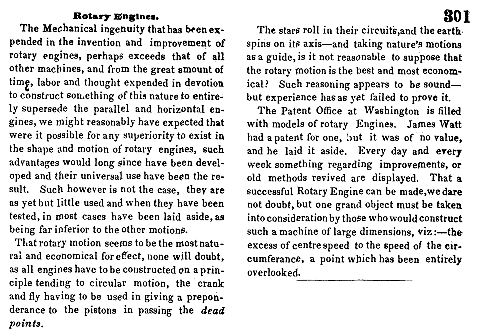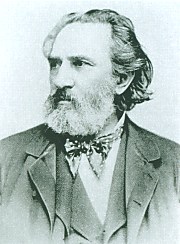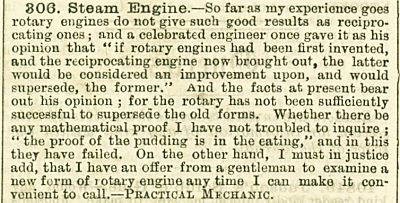Updated: 4 Mar 2011
Onion steam-wheel link added






Rotary Steam Engines: Contemporary Comments. |
Updated: 4 Mar 2011 |



JOHN SCOTT RUSSELL: 1838
 | Left: John Scott Russell (1808-1882)
Russell moved to London in 1844. He worked on the design of ships, becoming a director of a shipbuilding company. Isambard Kingdom Brunel who made him a partner in building the Great Eastern, but there were problems; Russell was in financial difficulties and the two men disagreed on aspects of the design and construction. (The Great Eastern was eventually launched in 1858) He was expelled from the Institute of Civil Engineers for some questionable arms deals during the American Civil War. |
Russell was a great scientist but a mediocre businessman and his reputation suffered from his disputes and financial irregularities. He died a relatively poor man in 1882.
John Scott Russell's main criticisms of rotary engines were:
"There are other defects to which this species of engine is particularily liable- to vacuities and losses at the valves and passages- to irregular action, and collisions and shocks from the action of the parts upon one another..."
Clearly in the last part of that quote he is thinking of the dreadful whack-a-butment designs where the moving parts hammered into each as the engine rotated. The first of many sad examples was The Watt Engine.

A VIEW OF AMERICAN ROTARY ENGINES: 1847
 | Left: This commentary on rotary steam engines appeared in Scientific American in June 1847.
The bit at the end about "the excess of centre speed" is wholly opaque to me. |

A WORD FROM GEORGE STEPHENSON: 1848.
 | Left: George Stephenson (1781-1848)
|
MR ONION then stated that his engine* had been working for some weeks at the Derby station, by permission of Mr Kirtley, the Locomotive Superintendant of the Midland Railway; and during that trial, experiments with his and another engine had proved that his effected a material saving in fuel.
THE PRESIDENT said that it appeared to him to be impossible that such could be the case. The engine might have answered at one trial, but it might fail at the next; and one trial was by no means a sufficent proof.
MR SLATE observed that there was one important desideratum which he desired to see obtained in the Rotary Engine- namely, some method of packing tightly. That had never yet been found. He had paid much attention to the Rotary Engine, and had seen approaches made to an efficient system of packing, but none had been so perfect as to render the rotary principle equal to the crank. Mr Onion had told them his engine was more simply packed than the common engine.
MR ONION said that Mr Scott Russell**, who had written on and patented several Rotary Engines, confessed to him that he (Mr Onion) had succeeded in overcoming difficulties which had hitherto been found to be insurmountable, such as making his engine steam-tight, and also in doing away with the usual noise*** of the Rotary Engine.
MR JOSEPH MILLER said that one great advantage of the Rotary Engine, supposing it to be thoroughly efficient, was the small space which it occupied... He had never yet seen a Rotary Engine rendered sufficiently tight, but he would not go the length of saying that it could not be done.
On being referred to, Mr HENRY ROBINSON said that the government had a Rotary Engine (Lord Dundonald's engine) working in the Portsmouth dockyard for the last seven years. Mr Onion claimed the credit of being the first who had ever suceeded in packing efficiently, but it was only the same as he (Mr Robinson) had been in the habit of using for years... If Mr Onion would call upon him in London, he would show him an engine similar to his own, and packed in the very same way. It was one that was applied to a locomotive, commonly known as the "Jim Crow" engine- from its having been painted black...
A member having spoken of Beale's Rotary Engine, THE PRESIDENT stated that he had been concerned in having a trial made of that engine, in a steam boat intended to carry passengers only half a mile, to Yarmouth; but when the engine was put to work he could not make the boat move forward, and so the experiment failed. He managed to get the boat to sea, and it cost him and his party £40 to bring her back again.
Not much enthusiasm for the concept here. Clearly sealing was a major problem.
* The only Onion engine I am aware of is Onion's steam wheel, which destroyed itself in a quite unique way after its first trial. It appears that a different rotary engine is being discussed here.
** This is John Scott Russell, mathematician, engineer, and discoverer of the soliton. See above for more on his views on rotary engines.
*** This hitherto enigmatic passage probably refers to the sort of rotary engines that struck their own internal parts as they rotated. For another example see The Chapman Engine which was reported to sound like a tilt-hammer in operation.
JOHN BOURNE: 1853
"It cannot be said that any one of the multitude of rotatory engines yet tried has been completely successful; nevertheless we are by no means of opinion that a good rotatory engine will never be discovered, but, on the contrary, believe that the reciprocating engine will yet be superseded by a rotary contrivance of a far simpler kind than any one now contemplates."
SFrom A Treatise on The Steam Engine in Its Application to Mines,Mills, steam navigation and Railways by the Artizan Society, ed John Bourne, pub 1853 Longmans
Some prescient words from John Bourne, anticipating the steam turbine.
As a practical man, however, he saw great difficulties in the way. He had never seen a Rotary Engine which remained tight for any length of time; and he should as soon expect to discover the perpetual motion as to make one which would.
All that he (Mr Robinson) was prepared to say about the engine (Lord Dundonald's) was that it had hitherto done the work which it was intended to do.
As to Lord Dundonald's engine, he was invited, on one occasion, to see it tried on the London & Manchester railway; but he refused to go, because he was convinced that a failure would be the result; and so it was, for the engine could not be made to draw a train of empty carriages.

 | Left: Franz Reuleaux (1829-1905)
|
In his book "The Kinematics of Machinery", which was published in English in 1876, and is considered the foundation of scientific kinematics, Reuleaux deals with many rotary steam engine designs from a strictly theoretical standpoint; the phrase "Reuleaux says..." will be found scattered throughout my pages on rotary steam engines. The main purpose of the book was not the study of steam engines, but to popularise a notation he had invented for describing mechanisms. (Charles Babbage invented a notation with the same purpose) Some of the diagrams in these pages retain the Reuleaux notation describing the engine, from which it can be seen to be somewhat opaque. So far I have found no evidence it was ever widely adopted.
Reuleaux says, at the start of Chapter 9 of his book:
"Such a multitude of arrangements have been devised- and are still being devised- for the carrying out of one and the same purpose, that it appears almost impossible for a single individual to reduce them all to order, or even find out their existence. The irrestible tendency towards the invention of "rotary" steam-engines has contributed greatly to increase the number of these arrangements. This tendency has given us many useless, or apparently useless, machines, and has been the means of wasting much thought and capital. Would-be inventors have again and again been warned of it, but the warnings do not seem to have had any effect."
CORRESPONDENCE FROM DESIGN AND WORK: 1880

 | Left: From Design And Work, 24 Jan 1880 p91
|
 | Left: From Design And Work, 31 Jan 1880 p115
|
COMMENTS IN ENGINEERING: 1939
"It is probable that it is this very variety that has been the curse of the postive acting rotary. For an inventor, finding by experiment that his first scheme was faulty, was less likely to persist with it and by steady minor alteration to improve it than to turn his attention to another variety, and experience further disappointment. By contrast the attention of succeeding generations of engineers has been continuously concentrated for a century and a half on pistons, connecting rod and crank mechanism so that as a result of persistent minor improvement it can today be so constructed as to run at speeds which the first users would have regarded as fantastic."
Possibly the unknown author was thinking of Cochrane or Galloway; almost all would-be inventors seem to have stopped at one design. He also ignores the fact that the rotary engine has geometrical problems that are inherent, and will not yield to dogged detail development.
Engineering went on to further misplace the plot:
"Much more complicated mechanisms have been made reliable as the result of the unremitting efforts of engineers striving towards a single end... and we see no reason why similar efforts directed towards perfecting the rotary should not yield equally encouraging results."
I don't buy this, and I don't see what technology the author is referring to. If a bit of machinery is unreliable and ineffective, no-one is going to wait generations for a practical version to come along. Newcomen's pumping engines were slow and horribly inefficient by later standards, but they could do the job of keeping a mine clear of water with acceptable economy, and so could be sold to hard-headed mine owners. If it had taken generations to come up with something commercially viable, nobody would have bothered.

As we have seen, the phrase "rotary steam engine" covers a very wide variation in construction. The British journal Engineering thought that was part of the problem, saying in 1939.
An interesting question is why Engineering should be concerning itself with rotary engines as late as 1939. One would have thought that at that time there would have been more important things to think about; we must be grateful that no-one tried to fit the Hawker Hurricane with a rotary steam engine.
Another point is that the Wankel rotary internal combustion engine has received an enormous amount of development, but remains deeply flawed.

   
|